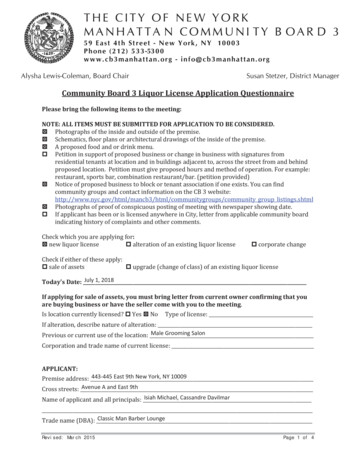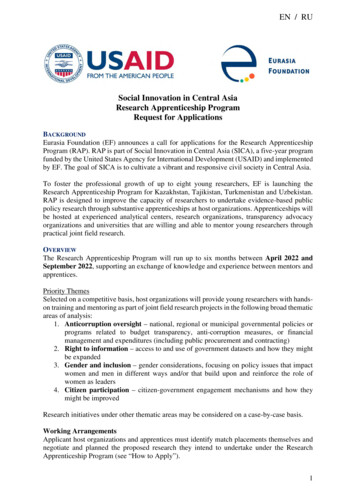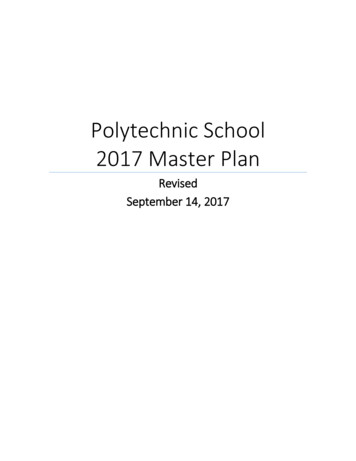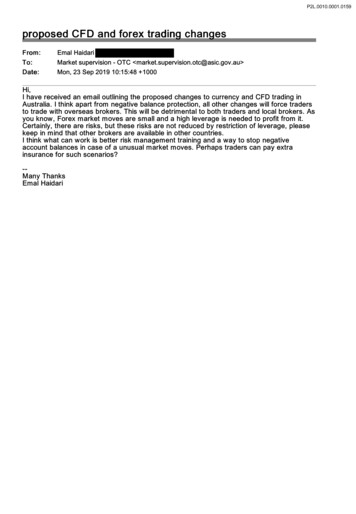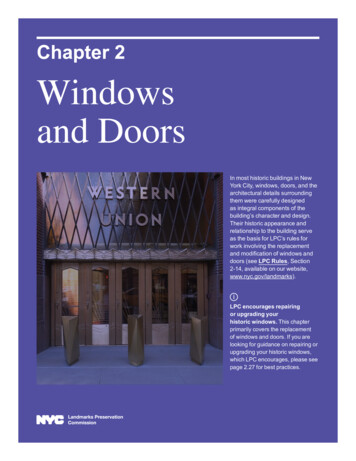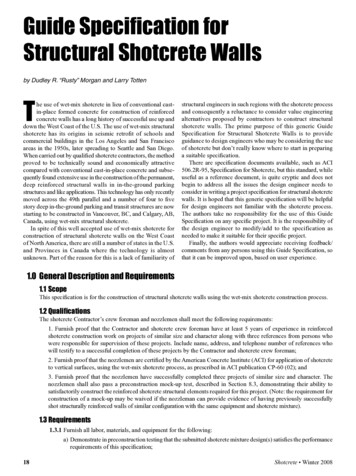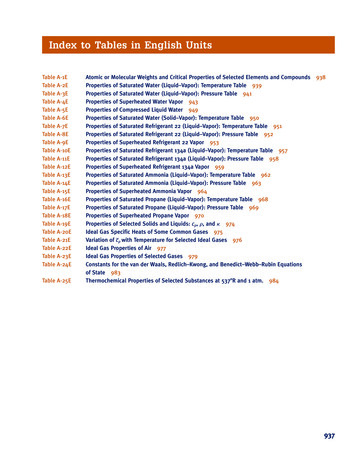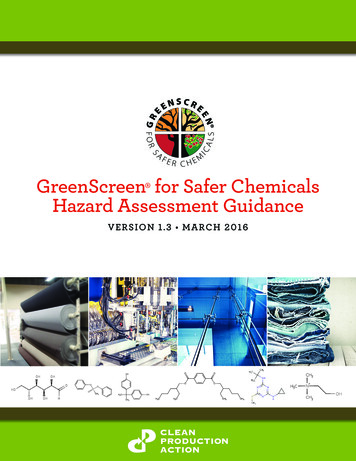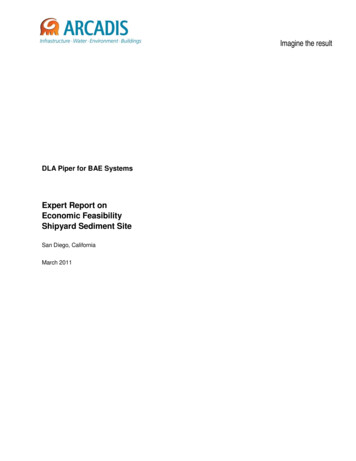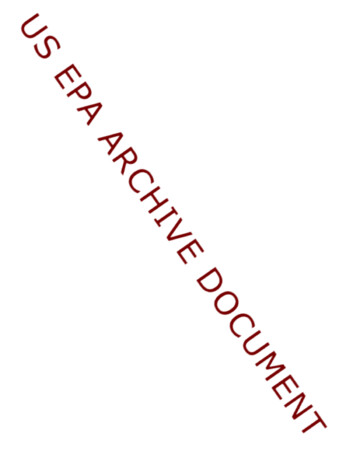
Transcription
Table L1. Proposed CO2 Injection Well – Casing SpecificationsTUBULARConductorSurface CasingProtection CasingCollapse/Burst ft)0 - 4013-3/848H-40ST&C770/1,730(X 1000 lbs.)541/3220 – 9659-5/836J-55ST&C2,020/3,520564/3940 – dWell Drilling ProgramThe following sections contain the proposed step-by-step program for drilling andcompleting the proposed CO2 Injection Well. The CO2 Injection Well will be used forbaseline monitoring and characterization, injection of the CO2 fluid during the activeexperiment, and post-injection monitoring of the intervals of interest.DRILLING PROCEDURECONDUCTOR HOLE1. Prepare surface pad location and install well cellar.2. Mobilize drilling rig. Perform safety audit during rig-up to ensure that equipmentsetup complies with project requirements.3. Notify Arizona Oil and Gas Conservation Commission at least 48 hours prior tospudding the well.4. Drill mouse and rat holes.5. Drill 17-1/2” conductor hole to /-40 feet. Install 13-3/8” casing and grout annularspace from set depth to surface with concrete.6. Wait on concrete to cure for 12 hours.SURFACE HOLE7. Rig up mud logging unit and test equipment. Collect and save 10-foot samples from40 feet to total depth. A set of samples is required to be submitted to the Oil andGas Administrator, Arizona Geological Survey, within 30 days of completion of thewell. Samples should be: 1) washed and dried, 2) place approximately 3tablespoons of sample in an envelope identifying the well, the well location, theArizona Oil and Gas Conservation Commission’s Permit Number, and the depth ofthe sample. Samples to be shipped to:Oil and Gas AdministratorArizona Geological Survey416 West Congress, Suite 100Tucson, AZ 85701L-2
8. Pick up 12-1/4 inch bit and the bottomhole assembly (BHA). Drill a 12-1/4 inchsurface hole to /-965 feet (below base of Schnebly Hill) using freshwater spudmud, as detailed in the Drilling Fluids Program section below. Take deviationsurveys every 500 feet and at total depth. The recommended maximum allowabledeviation from vertical is 3 degrees with a maximum recommended deviation of nomore that 2 degrees per 100 feet (to minimize dogleg severity) at any point in theborehole. If the maximum recommended deviation is exceeded, an evaluation willbe made to determine whether remedial action is necessary. After reaching surfacecasing setting depth, the drilling fluid will be circulated and conditioned to ensurecorrect fluid properties for the open hole logging and testing.9. Run open-hole formation evaluation logs per the requirements of the Well Logging,Coring, and Testing Program (See Attachment I above).If the logging procedure is extended and/or hole becomes sticky or unstable duringlogging, a conditioning/cleanup trip will be made with the drill string to circulateand condition the drilling fluid. The drilling string will be removed from the welland the logging program will be completed as planned.10. Notify Arizona Oil and Gas Conservation Commission at least 48 hours prior tosetting and cementing the surface casing.11. Lower the 12-1/4” drilling assembly in the well to the total depth. The drilling fluidwill be circulated and conditioned to ensure correct fluid properties for the casinginstallation and cementing. Remove the drilling assembly from the well.12. Run 9-5/8 inch surface casing to /-965 feet. See the Well Casing Specificationssection above for a detailed description of the casing and casing equipment.Reduce mud levels in surface circulating system and have additional tanks on handto recover any excess mud or cement that may be circulated to the surface.Designate a qualified person to observe the circulating system and monitor drillingfluid at all times during the cementing procedure. An accurate accounting ofvolumes will be critical information in the event that circulation is lost.13. Rig up circulating equipment and perform a pressure test on the lines. Circulate andcondition the drilling fluid to ensure correct fluid properties for the cementingprocedure. Reciprocate the casing continuously during the circulation of the drillingfluid.14. Cement the casing in place. Details of the cement blends proposed are located in theWell Construction Cementing Program section below.Be prepared to divert cement and cement-contaminated drilling fluid returns awayfrom circulating system and into appropriate containment. Use sugar to retard thepremature setting of the cement, if necessary.15. If no cement returns are observed at surface, contact wireline service provider andschedule a temperature survey to determine the top of the cement.16. Center the casing in the rotary table of the drilling rig after completing thecementing procedure and before the cement hardens.L-3
17. Cement the annular space that does not contain cement, if required. Fill the annulusspace by pumping cement through small tubing that has been run into the annulus tothe top of cement.18. After waiting on cement to harden for a minimum of 12 hours, cut off the surfaceand conductor pipe and install a 9-5/8 inch SOW (slip-on for welding) x 11-inch3,000-psi casing head flange. Perform a pressure test on the casing head afterinstallation. Digitally record the test and maintain a copy of the test results onlocation. Transfer the original test data to the Sandia Office for inclusion in the CO2Injection Well Report.PROTECTION HOLE19. Install 11-inch 3,000 psi double ram blow out preventer, 11-inch 3,000 psi annularpreventer, and auxiliary well control equipment on the 11-inch, 3,000 psi casinghead flange. Perform a pressure test on the equipment to the lesser of themanufacturer’s full working pressure rating of the system, 70 percent of theminimum internal yield pressure of any casing subject to test, or one psi per foot ofthe last casing string depth. Annular or bag-type preventers shall be tested to thelesser of 1,000 psi or 50 percent of the full working pressure on installation. Theblowout preventer and related equipment will be tested, as follows: a) after eachstring of casing is set in the well, b) not less than once every 14 days, and c)following any repairs that required the disconnection of any pressure seal assembly(note, only the repaired or replaced component need be tested unless alteration orrepair occurs at a normal full blowout preventer test period).20. Pick up an 8-1/2 inch bit, BHA, and trip in the hole to the top of cement with thedrill pipe. Include drilling stabilizers above the second and third drill collars. Closepipe rams and perform a pressure test on the surface casing for at least 30 minutes.The surface casing will be pressure tested for at least 30 minutes to 70 percent ofthe internal yield pressure of the casing or one pound per square inch (psi) per footof setting depth (whichever is less). A successful test is a drop of no more than 10percent of the test pressure over the 30-minute time period. Digitally record the testand maintain a copy of the test results on location. Transfer the original test data tothe Sandia Office for inclusion in the CO2 Injection Well Report.21. Convert the drilling fluid in the well to a salt-based drilling fluid. Details of thedrilling fluid characteristics are located in the Drilling Fluids Program sectionbelow.22. Drill out casing float equipment and 10 feet of new hole.23. Perform a pressure test on the casing seat and formation to pressure leak-off pointor to an 11.0 pounds per gallon equivalent drilling fluid density.24. Drill an 8-1/2 inch hole from surface casing point to the core point in the MartinFormation. Alternatively, sidewall coring may be done as part of the wirelineactivities in Item #26. Take deviation surveys every 500 feet and at core point. Therecommended maximum allowable deviation from vertical is 3 degrees with amaximum recommended deviation of no more that 2 degrees per 100 feet (toL-4
minimize dogleg severity) at any point in the borehole. If the maximumrecommended deviation is exceeded, an evaluation will be made to determinewhether remedial action is necessary. Details of the coring program are describedabove in Appendix I. Monitor the well path as drilling proceeds.25. Drill and retrieve the core (Martin proposed injection interval), unless sidewallcoring is done instead.26. Pick up the drilling assembly and lower into the well. Drill the cored interval (iftaken) and continue drilling to the proposed total depth ( /-4,000 feet true verticaldepth) into the Pre-Cambrian basement. Take deviation surveys every 500 feet andat total depth. The recommended maximum allowable deviation from vertical is 3degrees with a maximum recommended deviation of no more that 2 degrees per 100feet (to minimize dogleg severity) at any point in the borehole. If the maximumrecommended deviation is exceeded, an evaluation will be made to determinewhether remedial action is necessary.27. After reaching total depth, circulate and condition the drilling fluid to ensure correctfluid properties for the wireline logging procedure. Make a short trip by pulling upinto the 9-5/8-inch surface casing with the drill bit and BHA. Lower the drillingassembly back to bottom and check for solids fill. Resume circulating andconditioning drilling fluid and wellbore for open hole logging. Remove drillingassembly from well for open hole logging.Measure the drill string on the trip out to confirm well depth.28. Rig up wireline equipment and run the open-hole logging and sampling suite. SeeAppendix I for Well Logging, Coring and Testing details.If the logging procedure is extended and/or hole becomes sticky or unstable duringlogging, a conditioning/cleanup trip will be made with the drill string to circulateand condition the drilling fluid. The drilling string will be removed from the welland the logging program will be completed as planned.29. After completing all wireline logging and sampling, go into the hole with bit, drillcollars, and drill pipe to bottom. Check and note presence of any fill at the bottomof the hole. Circulate hole clean, condition the drilling fluid for running of theprotection casing. Note, a high viscosity pill may be required to keep the bottomportion of the hole open.30. Pull out of the hole with the drilling assembly. Lay down drill pipe and drillingassembly.Notify Arizona Oil and Gas Conservation Commission and USEPA of upcomingcement job at least 48 hours ahead of anticipated activities.31. Rig up casing handling and make-up equipment. Run the 5-1/2 inch protectioncasing. Details of the casing program are described in the Well CasingSpecifications section above. Set a differential shoe and a differential collarbetween the second and third joint.Ensure that all dimensions of cementing equipment and casing are visuallyinspected, measured, and drifted before running in the hole.L-5
API Modified thread lubricant or equivalent will be used unless premium threadsand/or corrosion resistant casing are used.Have a casing swedge available, on the rig floor, with circulating hoses ready, inthe event the casing must be washed to bottom or in the event that well controlprocedures are required.32. Once the casing is on bottom, rig up and circulate the hole for a minimum of 150%of the open hole volume to clear the floats and cool the formation sufficiently forcementing. Add water and chemicals to the drilling fluid to adjust the characteristicsof the fluid to improve drilling mud removal from the annulus during the cementingprocedure.Reciprocate the pipe slowly, but continuously, in 20-foot strokes during thecirculating and cementing operations. If the movement of the pipe begins to indicatethat sticking is occurring, lower the pipe to planned setting depth and discontinuepipe movement.Reduce mud levels in surface circulating system and have additional tanks on handto recover any excess mud or cement that may be circulated to the surface.Designate a qualified person to observe the circulating system and monitor drillingfluid at all times during the cementing procedure. An accurate accounting ofvolumes will be critical information in the event that circulation is lost.33. Mix and pump the cement. Details of the cementing program are described in theWell Construction Cementing Program section below. Displace the cement withdrilling mud, 2% KCl, or fresh water.34. Lift the BOP stack and hang off the 5-1/2” casing in tension (same hook load aswhen originally cemented in place). Nipple up the 7-1/16-inch 3,000 psi x 11-inch3,000 psi tubing spool and perform a pressure test on the seals to the manufacturer’sspecifications. Isolate the well by installing a 7-1/16-inch 3,000 psi tapped flangewith valve on the tubing spool.35. Rig down the drilling rig and release rig from location. Remove and clean locationof all drilling equipment.COMPLETION PROCEDUREPROTECTION CASING AND CEMENT EVALUATION1. Mobilize a workover rig to location and rig up the equipment (note that the drillingrig may be used for completion operations, depending on availability andscheduling). Perform safety audit during rig-up to ensure that equipment setupcomplies with project requirements.2. Install 7-1/16” 3,000 psi dual blow out preventer on well and pressure test.3. Pick up a 4-3/4-inch cement bit and two casing scrapers, trip into the hole with aworkstring to tag the top of cement in the casing.L-6
4. Verify tagged depth and dress off cement as needed. Circulate the fluid in thewellbore to remove any solids. Displace the wellbore with filtered 2% KCl or othersuitable completion fluid. Pull the workstring, scrapers, and bit.5. Rig up wireline equipment and lubricator to the top of the annular BOP. Perform a2,000-psig pressure test on the lubricator. Run cement evaluation/casinginspection/caliper logs, differential temperature survey, and gyroscopic survey asdetailed in Attachment I, Well Logging, Coring and Testing. Run cement bond loginitially under zero pressure. A repeat run at elevated pressure may be necessary toremove effects from potential micro-annulus. Run cement evaluation/casinginspection logs to surface or approximately 500 feet above the top of calculatedannular cement. Rig down wireline equipment.6. Perform a pressure test on the casing to 70 percent of the manufacturer’s ratedinternal yield pressure or one psi per foot of casing depth, which ever is less, for atleast 30 minutes. Note: Arizona Oil and Gas Conservation Commission and/orUSEPA may witness casing pressure test. A successful test is a drop of no morethan 10 percent of the test pressure over the 30-minute time period. Digitally recordthe test and maintain a copy of the test results on location. The original copy of thepressure test record MUST be sent in to the Sandia Office and made part of the CO2Injection Well report. Keep a copy of the pressure test record at the CO2 InjectionWell site with other important records.WELL COMPLETION – CO2 INJECTION PILOT7. Run any pre-experiment baseline testing that requires the well to be clear ofcompletion equipment (such as the baseline VSP).8. Rig up wireline unit and set up perforating charges. Run in hole and correlateperforation gun(s) on depth. Perforate the Martin Formation (or alternate NacoFormation) injection interval as determined from the open-hole logs. It isrecommended that the well be perforated underbalanced, to aid in perforationtunnel clean up.9. Produce formation fluid from the Martin Formation by swabbing or backlift. Thiswill also aid in developing the well. Monitor formation fluid properties at surface(chlorides, pH, temperature, specific gravity, etc.). Continue flowing the well untilparameters stabilize, indicating that formation fluids are being recovered. Collectsamples periodically for laboratory analysis. Once clean and stable formation brineis established, divert returns to a “fresh” frac tank(s). The stored formation fluidswill be used for injection testing of the injection interval.10. Pick up completion packer and tubing. Attach any downhole monitoring equipmentand control lines. Run the completion assembly into the well. Once on bottom,circulate the well with clean formation brine.11. Space out tubing string and set the packer /-10 feet above the uppermostperforation in the Martin Formation injection interval.12. Land the tubing into the wellhead.13. Install wellhead equipment and control lines.L-7
14. Allow well to equilibrate and perform annulus pressure test. The pressure test willbe run at equal to the lesser of the maximum authorized injection pressure or 1,000psi (no testing pressure will be less than 300 psi). A successful test is a drop of nomore than 10 percent of the test pressure over the 30-minute time period. Digitallyrecord the test and maintain a copy of the test results on location. Note: Arizona Oiland Gas Conservation Commission & USEPA may witness annulus pressure test.The original copy of the pressure test record MUST be sent in to the Sandia Officeand made part of the well report. Keep a copy of the pressure test record at the wellsite with other important records.15. Rig down the workover rig and move out associated equipment.GENERAL NOTESAll depths referenced are approximate and are based on the expected log depthfrom rig Kelly bushing of 15 feet above ground level.Actual depths may vary based on lithology and evaluation of local formations.DRILLING FLUIDS PROGRAMSurface HoleDepthMud Type(Feet)40-300Freshwater Gel300-965Freshwater GelWeight(Lb./gal)8.4 – 9.08.4 – 9.0Viscosity(Funnel-sec.)40 - 6050 - 60Fluid Loss(cc/30 min)control 10Notes:1. Should lost circulation and excessive drilling mud losses occur, materials designedfor that problem will be used to remedy the problem on an “as needed” basis.2. High-viscosity sweeps will be used as needed to assist in hole cleaning.Protection HoleDepthMud Type(Feet)965-2,300Saltwater Gel2,300-4,000Saltwater GelWeight(Lb./gal)9.5 - 10.59.5 - 10.5Viscosity(Funnel-sec.)35-4235-42Fluid Loss(cc/30 min) 10 5Notes:1. Should lost circulation and/or excessive drilling mud losses occur, materialsdesigned for that problem will be used to remedy the problem on an “as needed”basis.2. High-viscosity sweeps will be used as needed to assist in hole cleaning.L-8
Injection Well Report. 21. Convert the drilling fluid in the well to a salt-based drilling fluid. Details of the drilling fluid characteristics are located in the Drilling Fluids Program section below. 22. Drill out casing float equipment and 10 feet of new hole. 23. Perform a pressure test on the casing seat and formation to pressure leak-off .


